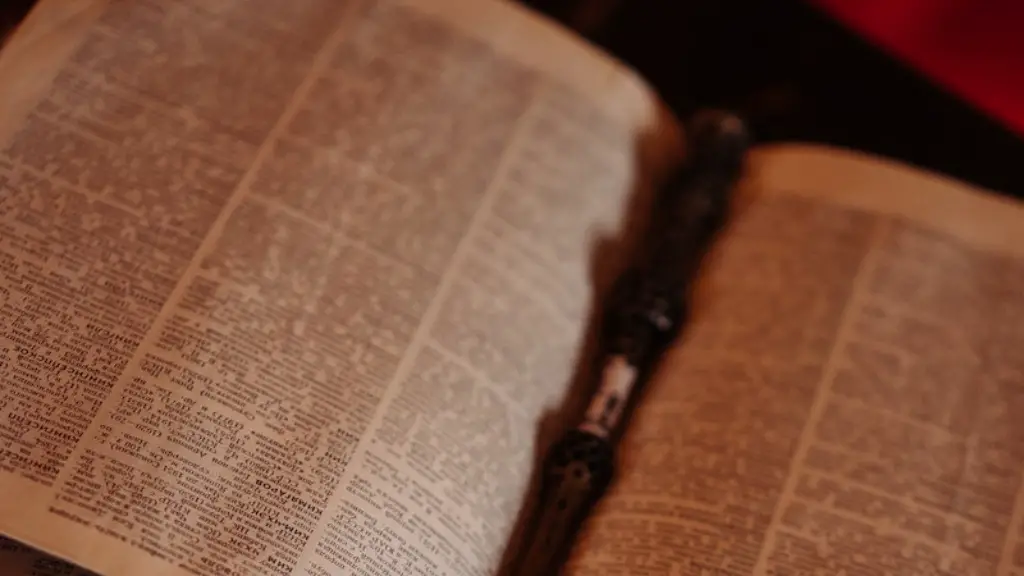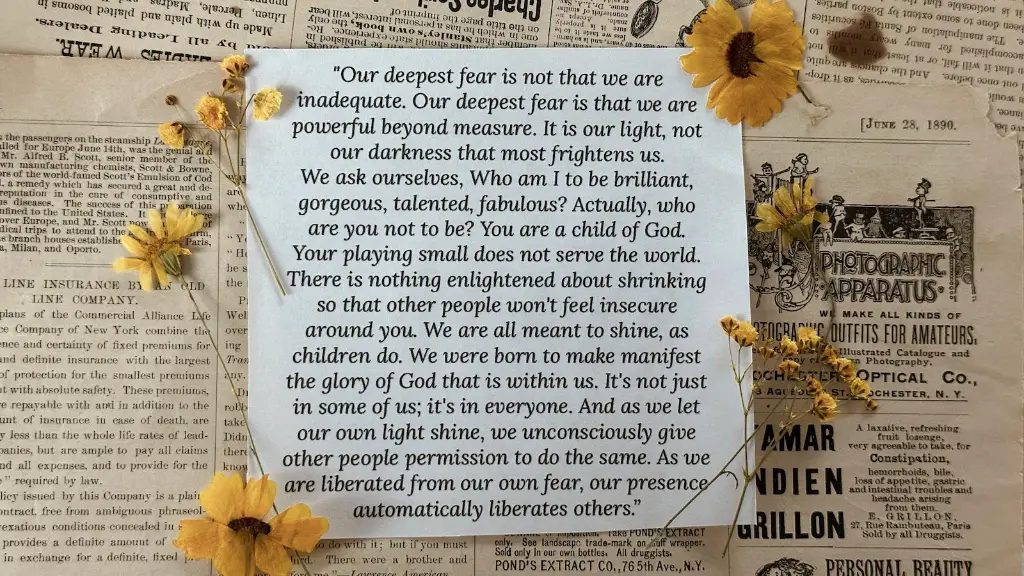There are many ways to interpret Emily Dickinson poems. Some people may read them literally, while others may see them as symbolic or Allegorical. Dickinson herself once said that her poems were meant to be read “between the lines.” This suggests that there is often more to her poems than meets the eye, and that they should be interpreted in different ways.
Emily Dickinson’s poems are often difficult to interpret because they are so concise and use many literary devices. However, careful reading and attention to detail can reveal the hidden meanings in her poetry. A good place to start is by looking at the poem’s title and form, as they can offer clues about the speaker’s state of mind and the overall tone of the poem. Additionally, looking at the poem’s diction, images, and symbols can also help to unlock its hidden message.
How do you analyze an Emily Dickinson poem?
1. Be open to linguistic surprise when reading a Dickinson poem. The poet often uses unconventional grammar and word choice, which can lead to interesting and unexpected interpretations.
2. Read the poem more than once. This will help you to better understand the poet’s meaning and to pick up on any subtle details you may have missed the first time around.
3. Be aware of the major characteristics of Dickinson’s poetry. This includes her use of enjambment, slant rhyme, and capitalization for emphasis.
4. Set aside the expectation that a poem has to “mean” one specific thing. Often, Dickinson’s poems are open to multiple interpretations.
5. Try “filling in the blanks” when reading. Sometimes, the poet leaves out key words or phrases, which can be frustrating. However, if you take the time to fill in these blanks, you may find that the poem takes on a whole new meaning.
Emily Dickinson was a keen observer of the world around her, and she used images from nature, religion, law, music, commerce, medicine, fashion, and domestic activities to probe universal themes. Her writing was often about what she knew and about what intrigued her, and she used her keen observational skills to explore the wonders of nature, the identity of the self, death and immortality, and love.
What was the main message for Emily Dickinson
Dickinson’s seclusion was both a choice and a necessity. As a young woman, she was not allowed the same freedoms as her male counterparts, and so she retreated to her family home, where she could focus on her writing. This focus allowed her to develop her unique style and voice, which addressed a wide range of emotions and topics. Through her poetry, Dickinson explored the human experience in all its forms, from the everyday to the metaphysical. Her work continues to resonate with readers today, nearly 150 years after her death.
Emily Dickinson is one of America’s most famous poets. She is known for her use of slant-rhyme, conceits, and unconventional punctuation. She was also a very reclusive person, rarely leaving her home.
What makes Emily Dickinson’s poetry unique?
Emily Dickinson’s writing style is most certainly unique. She used extensive dashes, dots, and unconventional capitalization, in addition to vivid imagery and idiosyncratic vocabulary. Instead of using pentameter, she was more inclined to use trimester, tetrameter, and even dimeter at times. This made her writing style very difficult to imitate, and ultimately what made her one of the most important and influential poets of her time.
There is a general consensus amongst scholars that Emily Dickinson addressed many of the same literary themes as her contemporaries. However, what sets Dickinson apart is the way in which she approached these topics. Love, death, and sentimentality were all common themes during her era, but Dickinson’s unique perspective and style set her apart from other writers of her time. War, religion, and other social issues were also important during her lifetime, and Dickinson’s treatment of these topics was often quite different from other authors. As Miller notes, this difference is one of the things that makes Dickinson’s work so special and timeless.
How is Emily Dickinson’s poem an allegory?
In “I Died for Beauty,” Emily Dickinson uses the allegorical figure of a person who died for beauty to explore the idea of self-sacrifice. The poem presents a conversation between two people who have died for different causes: one for beauty and one for truth. The speaker who died for beauty reflects on the fleeting nature of life and the transitory nature of beauty. Even though they gave up their life for something as fleeting as beauty, they do not regret their decision. The speaker who died for truth, on the other hand, tries to convince the other to give up their life for a cause that is more lasting. In the end, both characters die for their respective causes, but their conversation highlights the different ways in which people can give up their lives.
Dickinson’s poetry is unconventional in both theme and form. Themes of death, love, and nature are common, but her unique perspective and use of language set her apart from other poets of her time. The moods of her poems range from playful to dark and mysterious, and her short, concise poems are often untitled. Dickinson is also known for her individualism and transcendentalism, as well as her unbiased opinions on religion and politics. Her poetry often reflects her deep interest in mysticism and the spiritual world.
What literary techniques does Emily Dickinson use
Dickinson’s use of imagery, enjambment, and dashes is particularly interesting when examining her poetry for ambiguity. By using these devices, Dickinson increases the uncertainty found in her already ambiguous subjects. For example, by using imagery, Dickinson allows readers to create their own mental images of the scenes she describes. This often leads to different interpretations of her meaning. Additionally, enjambment can create a sense of ambiguity by breaking up the flow of thought and leaving readers to fill in the gaps. Finally, dashes can be used to create an abrupt change in thought or to emphasize a particular word or phrase. All of these devices contribute to the ambiguity of Dickinson’s poetry.
Emily Dickinson is often praised for her wide range of themes in her poetry. She tackles difficult topics like love, pain, suffering, death, and immortality with ease. She also addresses more lighthearted themes like nature and art. No matter what the topic, Emily Dickinson’s poetry always manages to capture the human experience in a way that is both relatable and profound.
What is the overall tone of Emily Dickinson’s poems?
Emily Dickinson is unique in that she has a couple of different tones in her poetry. She has death and suffering poems, in which she is quite pessimistic and depressing, very dark and gloomy. But she also has some poems that read like tiny essays with a cognition above and beyond all other poets.
Hope is the light that guides us through the darkness, the music that lifts our spirits when we are feeling down, and the thing that never lets us give up, no matter how hard things get. Hope is what makes us human and what makes life worth living.
Why did Emily Dickinson write about death
In the wake of losing a few dear companions, Emily Dickinson turned out to be increasingly melancholic and fixated on death. This disconnection from the world led her to spend the majority of her life shut away in her room, where she composed the greater part of her now-celebrated poetry.
Personification is a literary device in which an inanimate object is given human qualities. In the poem “We slowly drove–He knew no haste,” Emily Dickinson uses personification to compare death to a person. Death is personified as a driver who knows no hurry, and the speaker is a passenger who is slowly being driven to her death. This is a powerful way to show the inevitability of death, and how it is something that we all must travel together.
What kind of poems is Emily Dickinson known?
Emily Dickinson’s poems often employ short stanzas, usually quatrains, with short lines. The poems usually rhyme on the second and fourth lines. Other stanzas sometimes employ triplets or pairs of couplets, and a few poems employed longer, looser, and more complicated stanzas.
The house is a metaphor for the grave. Dickinson wants to enforce the idea that the speaker accepts and is comfortable with dying. She could have described the claustrophobic coffin, but she didn’t. She chose a metaphor familiar to the readers to illustrate the calmness of the speaker.
What are 3 interesting facts about Emily Dickinson
Emily Dickinson was an American poet who lived in the 19th century. She is considered one of the most important authors in American literature. Emily was born in Amherst, Massachusetts, in 1830. She was the second child of Edward and Emily Norcross Dickinson. She had an older sister, Lavinia, and a younger brother, Austin.
Emily’s father was a United States Senator and her family were devout Calvinists. Botany was a passion in her early years. She was an excellent student and graduated from Amherst Academy in 1847.
Emily became incredibly reclusive in her later years and only ten of her poems were published during her lifetime. Several mysterious love affairs may have taken place. Emily died in 1886 at the age of 55.
It’s so easy to feel lost and out of place, like you’re searching for something that you can’t find. But sometimes, all it takes is a change of perspective to realize that you’re exactly where you’re supposed to be. And that sense of peace and belonging is the most illuminating thing of all.
Warp Up
In order to interpret the poems of Emily Dickinson, one must first have a thorough understanding of her life and the times in which she lived. Her poems often reflect her own personal experiences and beliefs, as well as the larger social and political events of her day. Careful attention to the language and imagery used in her poems can reveal much about their meaning and provide insights into the mind of this great American poet.
Emily Dickinson is considered one of America’s greatest poets. She wrote over 1,800 poems, many of which were published posthumously. Her work is characterized by its use of simple language, unusual syntax, and slant rhyme. While her poems can be difficult to interpret, they are often rich in meaning. By carefully reading and re-reading her poems, and by looking at biographical information about the poet, readers can develop a deeper understanding of Emily Dickinson’s work.





